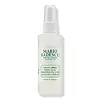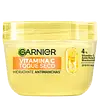Mario Badescu Facial Spray with Aloe, Adaptogens and Coconut Water Versus Garnier Hidratante Antimanchas Vitamina C Toque Seco
What's inside
What's inside
 Key Ingredients
Key Ingredients

 Benefits
Benefits

 Concerns
Concerns

No concerns
 Ingredients Side-by-side
Ingredients Side-by-side

Water
Skin ConditioningAloe Barbadensis Leaf Juice
Skin ConditioningNiacinamide
SmoothingSodium Hyaluronate
HumectantCocos Nucifera Water
MaskingAcanthopanax Senticosus Root Extract
Skin ConditioningInonotus Obliquus Extract
Skin ConditioningRhaponticum Carthamoides Root Extract
Skin ConditioningRhodiola Rosea Extract
EmollientSelaginella Lepidophylla Extract
EmollientSodium Benzoate
MaskingSodium Sulfite
PreservativeTrehalose
HumectantPotassium Sorbate
PreservativePPG-5-Ceteth-20
EmulsifyingCeramide AP
Skin Conditioning1,2-Hexanediol
Skin ConditioningMaltodextrin
AbsorbentCaprylyl Glycol
EmollientPhenoxyethanol
PreservativeCitric Acid
BufferingWater, Aloe Barbadensis Leaf Juice, Niacinamide, Sodium Hyaluronate, Cocos Nucifera Water, Acanthopanax Senticosus Root Extract, Inonotus Obliquus Extract, Rhaponticum Carthamoides Root Extract, Rhodiola Rosea Extract, Selaginella Lepidophylla Extract, Sodium Benzoate, Sodium Sulfite, Trehalose, Potassium Sorbate, PPG-5-Ceteth-20, Ceramide AP, 1,2-Hexanediol, Maltodextrin, Caprylyl Glycol, Phenoxyethanol, Citric Acid
Water
Skin ConditioningGlycerin
HumectantNiacinamide
SmoothingAlcohol Denat.
AntimicrobialIsononyl Isononanoate
EmollientSodium Carbomer
Emulsion StabilisingCitrus Limon Fruit Extract
MaskingSodium Hyaluronate
HumectantSodium Hydroxide
BufferingSilicon
AbrasiveSilica Silylate
EmollientAscorbyl Glucoside
AntioxidantCaprylyl Glycol
EmollientTrisodium Ethylenediamine Disuccinate
Xanthan Gum
EmulsifyingPolyglyceryl-2 Isostearate
EmulsifyingSalicylic Acid
MaskingChlorphenesin
AntimicrobialCI 15510
Cosmetic ColorantCI 19140
Cosmetic ColorantLinalool
PerfumingGeraniol
PerfumingLimonene
PerfumingParfum
MaskingWater, Glycerin, Niacinamide, Alcohol Denat., Isononyl Isononanoate, Sodium Carbomer, Citrus Limon Fruit Extract, Sodium Hyaluronate, Sodium Hydroxide, Silicon, Silica Silylate, Ascorbyl Glucoside, Caprylyl Glycol, Trisodium Ethylenediamine Disuccinate, Xanthan Gum, Polyglyceryl-2 Isostearate, Salicylic Acid, Chlorphenesin, CI 15510, CI 19140, Linalool, Geraniol, Limonene, Parfum
 Reviews
Reviews

Ingredients Explained
These ingredients are found in both products.
Ingredients higher up in an ingredient list are typically present in a larger amount.
Caprylyl Glycol is a humectant and emollient, meaning it attracts and preserves moisture.
It is a common ingredient in many products, especially those designed to hydrate skin. The primary benefits are retaining moisture, skin softening, and promoting a healthy skin barrier.
Though Caprylyl Glycol is an alcohol derived from fatty acids, it is not the kind that can dry out skin.
This ingredient is also used as a preservative to extend the life of products. It has slight antimicrobial properties.
Learn more about Caprylyl GlycolNiacinamide is a multitasking form of vitamin B3 that strengthens the skin barrier, reduces pores and dark spots, regulates oil, and improves signs of aging.
And the best part? It's gentle and well-tolerated by most skin types, including sensitive and reactive skin.
You might have heard of "niacin flush", or the reddening of skin that causes itchiness. Niacinamide has not been found to cause this.
In very rare cases, some individuals may not be able to tolerate niacinamide at all or experience an allergic reaction to it.
If you are experiencing flaking, irritation, and dryness with this ingredient, be sure to double check all your products as this ingredient can be found in all categories of skincare.
When incorporating niacinamide into your routine, look out for concentration amounts. Typically, 5% niacinamide provides benefits such as fading dark spots. However, if you have sensitive skin, it is better to begin with a smaller concentration.
When you apply niacinamide to your skin, your body converts it into nicotinamide adenine dinucleotide (NAD). NAD is an essential coenzyme that is already found in your cells as "fuel" and powers countless biological processes.
In your skin, NAD helps repair cell damage, produce new healthy cells, support collagen production, strengthen the skin barrier, and fight environmental stressors (like UV and pollution).
Our natural NAD levels start to decline with age, leading to slower skin repair, visible aging, and a weaker skin barrier. By providing your skin niacinamide, you're recharging your skin's NAD levels. This leads to stronger, healthier, and younger looking skin.
Another name for vitamin B3 is nicotinamide. This vitamin is water-soluble and our bodies don't store it. We obtain Vitamin B3 from either food or skincare. Meat, fish, wheat, yeast, and leafy greens contain vitamin B3.
The type of niacinamide used in skincare is synthetically created.
Learn more about NiacinamideSodium Hyaluronate is hyaluronic acid's salt form. It is commonly derived from the sodium salt of hyaluronic acid.
Like hyaluronic acid, it is great at holding water and acts as a humectant. This makes it a great skin hydrating ingredient.
Sodium Hyaluronate is naturally occurring in our bodies and is mostly found in eye fluid and joints.
These are some other common types of Hyaluronic Acid:
Learn more about Sodium HyaluronateWater. It's the most common cosmetic ingredient of all. You'll usually see it at the top of ingredient lists, meaning that it makes up the largest part of the product.
So why is it so popular? Water most often acts as a solvent - this means that it helps dissolve other ingredients into the formulation.
You'll also recognize water as that liquid we all need to stay alive. If you see this, drink a glass of water. Stay hydrated!
Learn more about Water